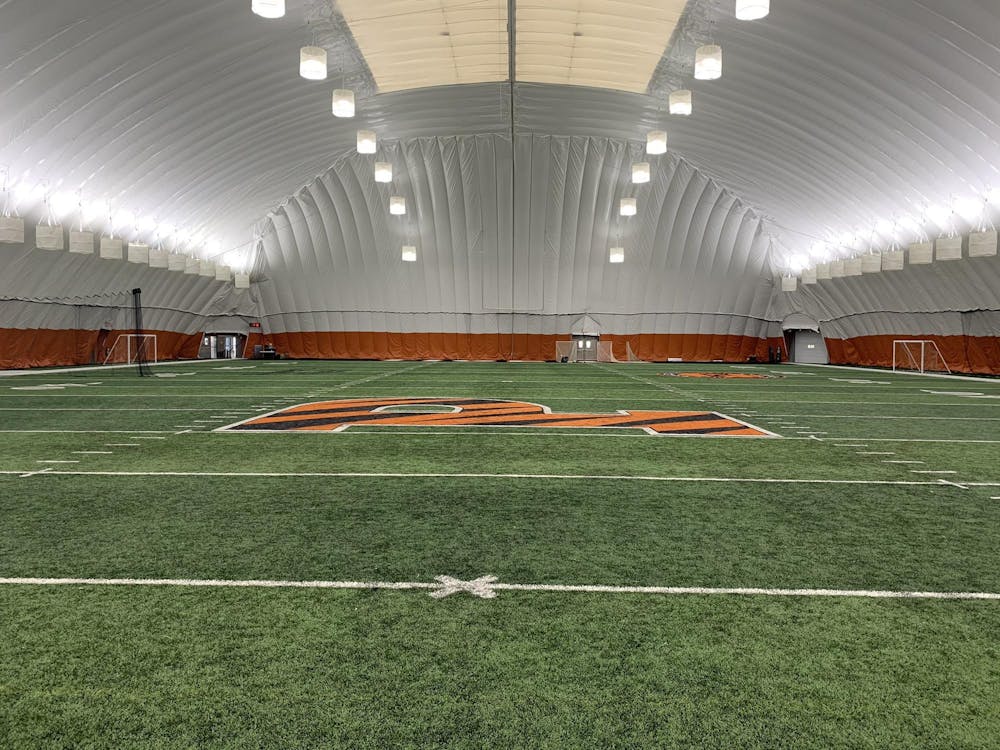February 14th — Valentine’s Day — is undeniably all about the heart. Heart-shaped cards, heart-shaped boxes of chocolates, heart-shaped SweeTarts. Love poems, cards, messages, and declarations of love — all come right from the heart.
But for athletes across Princeton’s 38 varsity sports, Valentine’s Day is not the only day the heart is on the mind. All athletes have different approaches to keeping their hearts healthy and in prime condition for performance all year round.
The men’s water polo team stays in the water for their conditioning. “When we condition, we typically focus on swimming ‘legs’ or a combination of the two,” senior Isaac Rotenberg wrote to The Daily Princetonian.
“A typical swim set would be fairly comparable to what a swimming team might do, just with a greater emphasis on freestyle,” explained Rotenberg, who plays the utility position. “‘Leg’ sets often revolve around treading water with some form of resistance, whether that be holding a weighted ball or with an elastic band attached.”
Leaving the water for the court, the men’s squash team trains much differently. They focus on High-Intensity Interval Training, or HIIT. “[HITT] is basically the opposite of running long distance, so it’s short intervals and 100% intensity,” junior Hassan Khalil told the ‘Prince.’
Squash involves short sprints with lots of stopping, starting, and changing direction. However, squash matches can last up to 90 minutes, so the team must build their endurance and their ability to sprint for as long as a point lasts.
“You’ve got to show intensity and maintain it, so you have to have the ability to quickly play 100 percent and recover, and then you also have to have the ability to keep repeating that for a long time, for, I’d say, between 60 and 90 minutes,” Khalil explained.
In order to reduce the load and impact on their joints for a sport that is notoriously difficult on knees and ankles, the squash team does sprints on the exercise bike or uses a much-disliked machine called the assault bike — an exercise bike with a big fan as the front wheel, providing huge resistance.

On the field, women’s lacrosse meets with their strength and conditioning coach every Thursday morning during the offseason for a specific conditioning workout, separate from practice.
“We usually start with a warm up, then we do some stuff to work on dynamic movements, maybe cone drills, ladder drills, hurdle drills — quick short movements for fast twitch type drills,” junior Abigail Roberts detailed to the ‘Prince.’ “And then at the end of every session, we do our conditioning, which usually takes between like 10 and 15 minutes. It can be anything from 150 yard shuttles, 300 yard shuttles, to 300 yard sprints.”
The team avoids long, endurance runs because it does not match lacrosse’s demands on their bodies.
“In our sport, you’re never really going to be running for seven minutes,” explained junior attacker Kendall Dean. “It’s a lot of starting and stopping — which we need to a, prepare our bodies for, and b, learn how to do that efficiently.”

In season, the actual games provide plenty of conditioning for the players, so conditioning is no longer a distinct aspect of training. However, players use data from the Catapult trackers, which are worn by players and measure distance run and speed, among other categories, to see if they are meeting sufficient levels of output in a game. If not, they condition on their own to stay in peak shape.
Rotenberg, Khalil, Roberts, and Dean all have different plans for staying in good cardiovascular shape once they leave their sports upon graduation.
Rotenberg plans on staying in the pool.
“As of the season ending a couple months ago, I have effectively retired from water polo,” wrote Rotenberg. “So far I have been swimming as my main form of cardio because I neither have the desire or the capacity to run.”
For Roberts and Dean however, the sprint-heavy nature of their lacrosse conditioning seems less attractive outside of the sport.
“I’ll definitely be changing my workouts,” said Dean.
“I can see myself going on longer runs and moving my body slower, but for a long time,” she told the ‘Prince.’ “I just feel like that’s an easier and more accessible way of working out, especially if you end up in a city, because I know a lot of cities don’t have fields for sprints.”
Roberts hopes to leave direct cardio training far behind, citing her dislike for sprints and long runs. Instead, she will look to recreational sports.
“Honestly, I’d use sports like tennis and pickleball,” she told the ‘Prince.’ “Things where you can move, but it’s a little more of an activity, because I really, really hate most forms of cardio.”
Khalil aims to combine his lifetime love of squash with his need to stay in good cardiovascular condition once he finishes his competitive career.
“I think that when I stop playing competitively, I’m gonna play squash — that’s going to be my way of staying fit — recreational squash,” he said.
Outside of squash, Khalil plans on switching up his exercises, trying out programs like CrossFit so as to mix up his routine.
From swimming laps, to sprinting in the gym on a bike, to shuttle runs on the lacrosse field, Princeton athletes keep their hearts in ideal competitive shape in a variety of ways. For many, a healthy heart is not just a requirement for their sports, but a lifetime goal.
Harrison Blank is a Head Sports editor at the ‘Prince.’
Please send any corrections to corrections[at]dailyprincetonian.com.








